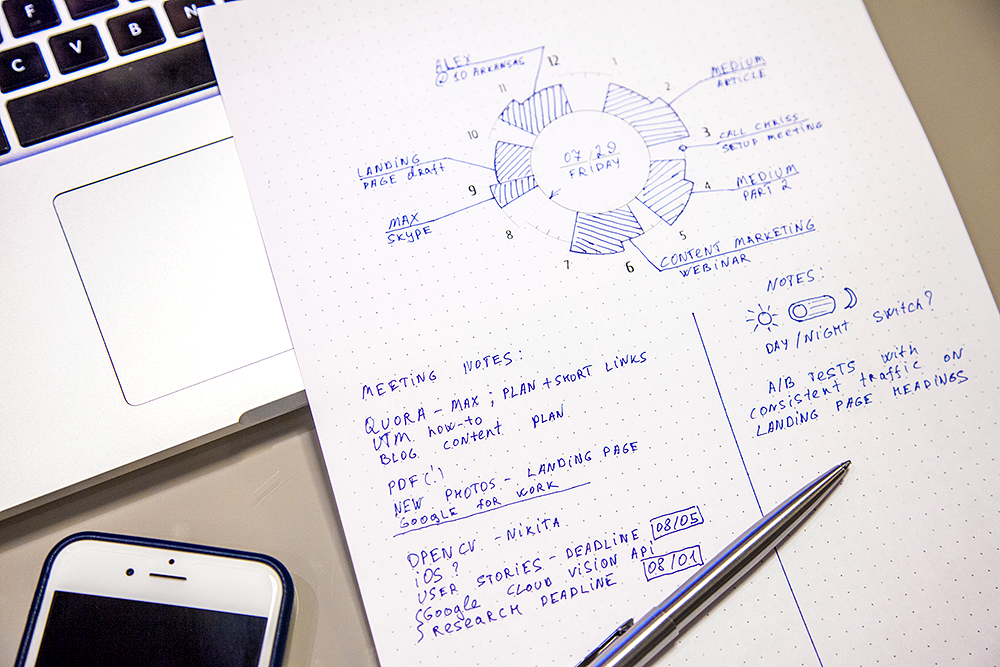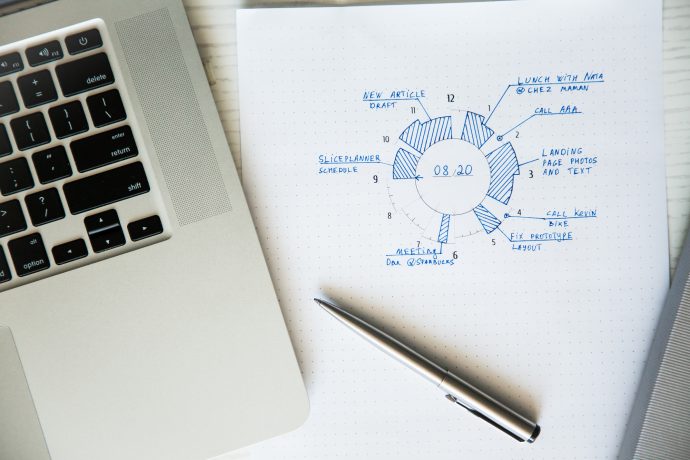Planning is a habit. I think most people would agree that it’s the most beneficial skill to develop. The skill of planning is simply a habitual process that we perform in order to achieve a given result: overall organization, good time management, and especially increased productivity. If you can improve the quality of the initial process of planning, you can strengthen the habit and thus consistently arrive at better results. I have found that if I have the ability to organize my day and its events in such a way that I can interpret them graphically, I improve my planning process, achieve better productivity, and indeed master my time.
How Do You See Time?
There are at least two conventional images that come to my mind when I visualize time. Everybody recognizes these time measurement tools from an early age.

Nothing is wrong with these tools. For a long time, both analog and digital clocks have been helping humans to be in a particular place at the right time in order to get things done. They are time proven.
Some people have a strong sense of time, while some, like myself, can easily slip an hour if not looking at a time measuring device. Both types of people would probably lose the sense of time in a casino where by design there are no windows or clocks. Our minds are not so good at following time without prompts. These cues could be the Sun, clocks, colleagues leaving the office, or hunger, to name a few. Yet if you’re comfortable and fascinated with something, I’ll bet you, like I, have easily lost an hour when busily engaged in work or play. Isn’t it funny though how evolution has given us skills to build a mechanism for time measurement rather than allowing us the simple ability to orient ourselves in time?
I remember when I was a kid, and the passage of time seemed unbelievably slow (there is a good explanation of this cognitive illusion here). Perhaps I mentioned this to my family, because when my sixth birthday rolled around, my parents gave me my very first digital watch. It thrilled me that I was, at any moment, able to see and identify the very exact moment in time. I remember proudly and importantly checking my new watch often and telling myself the time: “It’s now Twelve Thirty-Seven PM. It’s now “Eight Thirty-Nine AM”, regretting that adults didn’t feel the same urgent need to know the exact seconds. I was very proud to know where precisely in time I was.
My analog watches weren’t so exciting at first; I had to think and used to spend time figuring out first the hour and then the minutes. It was really hard to tell if it was “Twelve Thirty-Seven PM” or “Twelve Thirty-Eight PM”. It seemed too challenging and not fast or exact enough for me, so I chose to use digital watches all the time.
But something weird happened later on. I don’t know if it happens to everybody or just me, but at the age of about 10, I was able to tell at what point of time I was situated after just a quick look at any analog clock. I still didn’t know exactly if it was thirty-seven or thirty-eight. I didn’t need to know. I found that as I was getting older, my time perception became quicker and easier, and I wasn’t so excited anymore about the digital display of passing seconds.
Interestingly enough, it was only a couple of years ago that I realized the difference between those two watches. I mean, not only the way these devices display time but a major difference in how I understand the time when looking at them.
So here is my explanation:
Analog – you see the Past, the Present and the Future.
Digital – you only see the Present.
There is no real problem in using digital time output. I use it every day. In the present day, billions of people use digital watches. We haven’t forgotten our past; we haven’t stopped making plans for the future.
It is that clearer understanding of time that led me to a deeper consideration of how I could use the clock as a planning format.
Creating a Planner for Myself
There are some obvious questions that arise from the above. I would be absolutely fine using the digital clock. Its use just creates one small additional load on my brain, requiring me to construct a daily time projection in order to facilitate the organization of future events. The same applies to the analog clock. I have my plans stored somewhere besides my clock, perhaps in a paper planner or a digital calendar and whatever form of time visualization I use, my brain is building a projection of events from the timeline. Actually, digital calendars do it pretty well, and I can certainly see where I am in time, moment by moment. All future events are aligned digitally in a flat timeline. Still, I really miss the sense of being able to look at my analog watch briefly to come up with an understanding and some immediate sense of time.
So I began thinking: if only I could make a projection of my daily events from a calendar to the analog clock. It was a simple idea, and I’m quite sure that I wasn’t the first who discovered it. Normally, I start my day at 8 to 10 AM. I never plan anything that should be scheduled in the planner after 8 PM, so I would need one clock face where I could place all my appointments and events.

This was something that I put on my desk at first. However, with my “gorgeous” calligraphy skills, even that becomes a mess on the page pretty quickly if I need to schedule several subsequent events.
Once while I was looking for a biography of “The Hitchhiker’s Guide to the Galaxy” author, Douglas Adams, I accidentally hit on an article about human brain-friendly watches.
In part it says:
In the early days of personal computers, he said, people got very excited that their spreadsheet programs could finally create pie charts. This was considered a revolutionary advance, because as everyone knows, a pie chart visually represents a part-whole relationship in a way that is immediately obvious—a way that, to be more specific, mere columns of numbers did not. Well, the hands of an analog timepiece form wedges that look very much like a pie chart, and like a pie chart, they represent a sort of part-whole relationship in a way that requires a bare minimum of mental effort to comprehend. Not so digital timepieces, which for all their precision say nothing about the relationship of one time of day to another.
Interesting standpoint for a technology activist, isn’t it?
I realized that it might not be just me who would like to and would benefit from seeing the part-whole relationship of my day’s workload displayed in analog fashion. I had never used a format like it before, but there is a name for the type of pie chart that I needed for my calendar day view, and it’s called a “doughnut” for obvious reasons… I’m quite sure that I’ve seen this type of pie-chart a million times before, but sometimes you have to see it at exactly the right moment in order to realize that it is the perfect solution – a pie-chart-in-the-face solution.
I switched to the simplest possible doughnut diagram and came up with this:

It’s quite an obvious solution. Actually, I found out that there are many circular timelines around, although most people try to convert it to a 24-hour format for some reason. I didn’t want that. My working day rarely lasts more than twelve hours, so this worked really well for me, and I thought this might be the case for most other people as well.
Trials and Tweaks
I experimented and adjusted my day view calendar until I thought it was finally good enough to use without getting messy. So I printed those circular diagrams on regular letter-sized paper and started utilizing them on a daily basis. You’ve probably already guessed what happened next – I messed up days. Nothing critical, but it was one more thing for me to tweak, and I had space to do so. Plus, prior to that, I was not using any indicators for the start of my day. I knew when my regular day started, but just to be a little fancier, I added arrows which indicated the start hour of my day.

In the long run, I moved to thinner lines and a font more to my liking and added 15-minute delimiters. I can’t say if it had any impact on the way I scheduled my day, but yes, sometimes I did tell people that I wanted to meet at 6:15. It might sound strange, but this precision reminded me of my digital watches.

The next iteration of the concept came out recently when I found the Chronodex community that has its foundation on a long-gone Singapore based Muji Chronotebook. They use a more advanced radial representation that is able to fit in all 24 hours based on the Asian perception of time unfolding. I thought that might be overkill for a regular guy like me (plus I’d need to read the manual first), but adopting the slightly exploded doughnut pie chart model seemed like a really good idea.

Even this version has its limitations. Don’t expect to be able to plan two tasks at one time. In fact, the monochronic time culture almost universally encountered in Western civilization does seem like a natural behavior that prevents us from multi-tasking. I have found an interesting article on Medium that explains from a scientific point of view why doing multiple things simultaneously is actually counterproductive.
Ultimately, I found using this diagram as simple as glancing at an analog watch where I can actually see the representation of the past, the present, and the future while simultaneously viewing a single part of my day in relationship to the entire day.
For me, this visual time management diagram works like my mind works, so I can see my daily schedule laid out as I imagine it on a clock face. It’s a bit more natural than a regular planner where you see all your events in the linear format of a plain text. Using a “doughnut” planner concept, I feel like I have become more organized. This transition reminds me of that moment of epiphany many years ago when I suddenly began to comprehend the concept of time from a glance at an analog clock without thinking about the actual present hour and minute.
But what’s the benefit of having or using this method of daily planning? I mean, what do I really get from this apart from a subjective productivity boost and the ability to get a visual sense of what parts of my day are heavily scheduled?
It’s a valid question. I do like to write things down, and I consider myself a more visual thinker. Statistics prove that 60-65 percent of people in the world also learn, think, and plan visually. The circular timeline doesn’t feel like an invention by itself. I think it’s giving me some benefits in a better understanding of my tasks prioritization and the ability to reorder my day more efficiently, but of course, it’s not a silver bullet. At the same time and for the long term, changing the process of planning to the one that best suits my brain will quite likely benefit the overall quality of my planning.
I’ve created a PDF that is available here: http://sliceplanner.com/pdf
Please feel free to try this type of daily planning system.
PDF is for a letter-size sheet and contains 1 or 2 diagrams per page, each with a dotted grid background. This may also be printed and assembled by you for your favorite notebook/planner/paper format.
I don’t use paper planning daily, just from time-to-time when I feel my productivity is low. This is one of those days, and I’ve used one printed diagram on the page:

Our Future Vision
We live in a modern world where it’s almost impossible to avoid the very device that you are using to read this text now. I do not live “back in the day” either. My daily activities are inundated by the use of digital devices. I use a computer for work, so like you, I have a lot of things happening on my digital calendar too.
This circular timeline project was never meant to go any further than my desk, but we decided to put our heads (and our skills) together and push a bit further. Because digital calendars are so prominent and essential in today’s world, we are building a bridge with computer vision technology to connect this circular diagram from paper with major digital calendars: e.g. Apple, Google, Outlook.
Stay tuned!


Hello Oleksii,
Read your article word to word, and I found your ethos behind The Slice Planner quite impressive.
And a huge thank you for sharing the pdf sheets with all of us!
Gonna use them myself and let you know what I make of it.
Eagerly waiting for the app to be released on iOS!
Best,
Saif
I am interested in the product. When will the app come out? I want to know. Thank you.